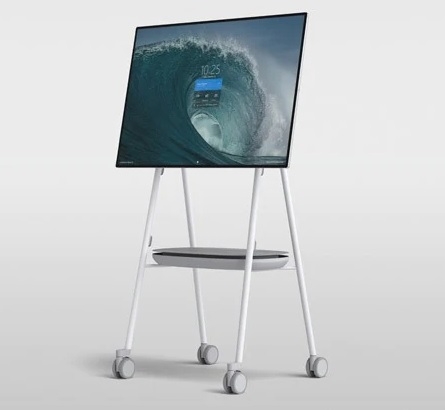Microsoft Surface Hub 2S: Not a High-Volume Device, but It’s On-Message and Ties Together Tech from Across the Company
Bottom Line
Microsoft’s Surface line stretches from headphones to corporate boardroom tools, but it’s all cohesively centered on productivity. The Surface Hub 2S adds features and functionality from across Microsoft while getting the previously fixed collaboration tool out of the conference room.
Analysis
Techsponential attended Microsoft’s small joint press conference with Steelcase last week at Steelcase’s New York City offices to launch new versions of the Surface Hub. The Hub is a super scaled-up version of a Surface tablet; Microsoft’s combination electronic whiteboard, conferencing solution, and interactive monitor. It has always been a bit of an anomaly for the company, aimed exclusively at large and medium sized corporate customers. Microsoft has said it sells consistently, though sales volumes are likely quite low. The high margins likely justify the production costs, but, by itself, would not cover the opportunity cost of building an ambitious niche product over a more mainstream Surface device. However, Hub maps perfectly to Microsoft’s overarching goal of improving productivity, and ties together services and technologies from across the company. (I have not seen any when I have been on Microsoft campus tours, but I like to think that Microsoft Surface team members use the Surface Hub internally and have a stake in improving it.)
The big updates with the Surface Hub 2S are mobility and size. Microsoft announced two Surface Hub 2S’: a 50.5” version with an optional battery pack and rolling Steelcase stand, and a monster 85” Hub 2S for boardroom installations. Thanks to the 3:2 aspect ratio, even the 50” version is 20% larger than an equivalent television. That version can be mounted on the wall vertically or horizontally, but it can also be mounted on Steelcase’s rolling stand (more on Steelcase below) and kitted with a custom battery to allow sharing it among conference rooms or pulling into different areas of open office layouts.
Modular Design
A Surface Hub is more of a long-term purchase than a PC, so Microsoft is using modular design for the first time on a Surface. This should enable IT managers to swap in more modern computing components while keeping the expensive (and slower evolving) display portion. Modular design won’t work for Surface products designed for mobility, but would be perfect for the all-in-one form factor Surface Studio. This report was written on a first-generation Surface Studio, which has computing specs that were somewhat outdated before it even shipped, but still has the best monitor at Techsponential’s offices.
Hardware and Software
Microsoft updated the Surface Hub 2S’ camera and software so that the Hub 2S can replace dedicated video conferencing systems, even if the interactive whiteboard functions or presentation capabilities are not needed. However, if you do want to mark up a document or take notes onscreen, the new thick nubby Pen feels great to write with. AI allows you to intelligently cut and paste segments of drawings and diagrams; in the context of a business meeting it is hard to label intelligent lassoing ink, “delightful,” but it is certainly fluid and useful. Surface Hub 2S runs on Windows 10 and integrates with Microsoft enterprise software suites, such as Teams, Office, and Power BI. However, Microsoft explicitly talked about and demoed cross-platform usage. Microsoft knows it lives in an iOS and Android world, and even products aimed at tying together Microsoft technologies are also designed to work well with iOS and Android.
Competitive Landscape
The Surface Hub has plenty of indirect competitors – electronic whiteboards, conferencing systems, business projectors, and even analog whiteboards. It has no direct competition, which enables Microsoft to sell it based on the value it provides corporations rather than compete on price. While some buyers will undoubtedly get discounts, the list price is significant: the 50.5” version sells for $8999.99 without the stand, mount, or battery. The 85” version is priceless, in that it does not have a price yet.
Steelcase Contributed More Than Just a Venue
The most obvious connection between Surface and Steelcase is a $1445 rolling stand specifically designed for the Surface Hub 2S. Two people can place the Hub 2S on the stand Steelcase used the event to announce Roam, a line of configurable office furniture specifically designed to mitigate many of the problems with open office architecture. Desks and partitions can be reconfigured on the fly, enabling workers to quickly collaborate, create semi-private spaces, and then change again. Roam looks great, though we question whether companies who pay lip service to productivity and use this office layout to save money will be willing to pay a premium to actually enable productivity.
Report Contact
To discuss the implications of this report on your business, product, or investment strategies, contact Avi at avi@techsponential.com or +1 (201) 677-8284.
Press Release
https://www.microsoft.com/en-us/surface/business/surface-hub-2?SilentAuth=1?SilentAuth=1
Key Specs
50.5” 3:2 4K+ resolution PixelSense touchscreen display with 15mm bezels
61.6 lb (designed to be easily mounted by two people)
Windows 10, Microsoft Teams for Surface Hub2, Skype for Business2, Microsoft Whiteboard, Microsoft Office (Mobile), Microsoft Power BI2
Intel i5 8th Gen Core processor
4K camera with 90 degree HFOV, attaches magnetically in vertical or horizontal orientation with USB-C
Surface Hub 2 Pen included
Optional APC Charge Mobile Battery, 100 minutes unplugged use
Optional Steelcase Roam mobile stand






